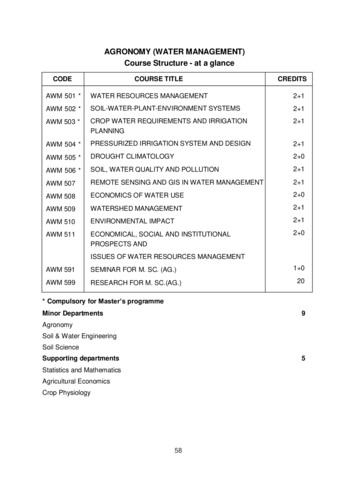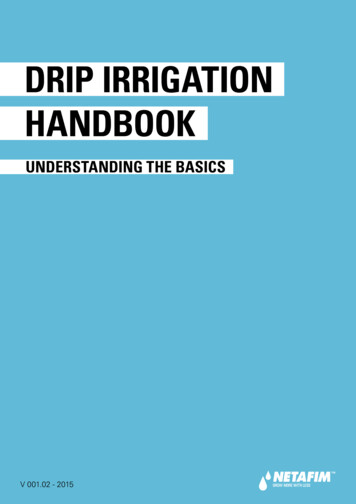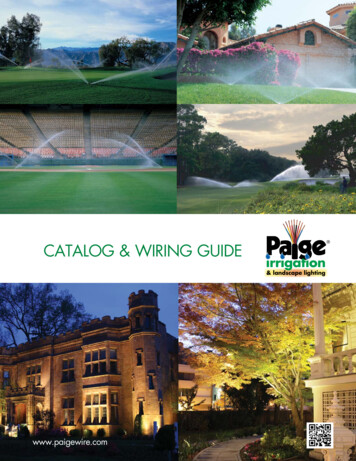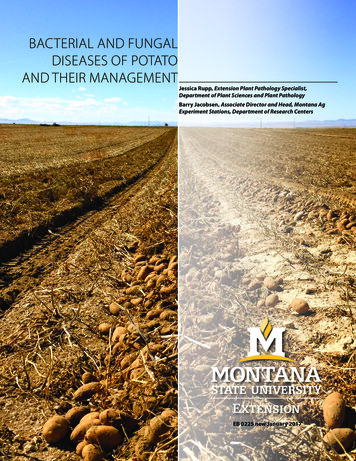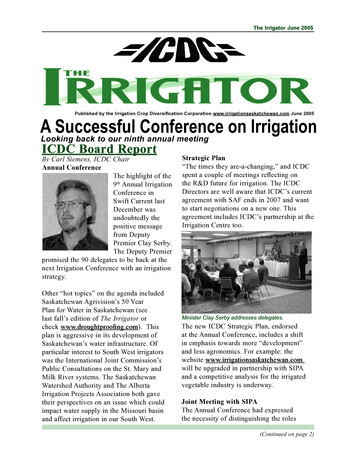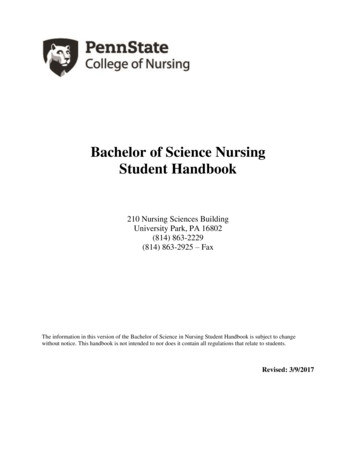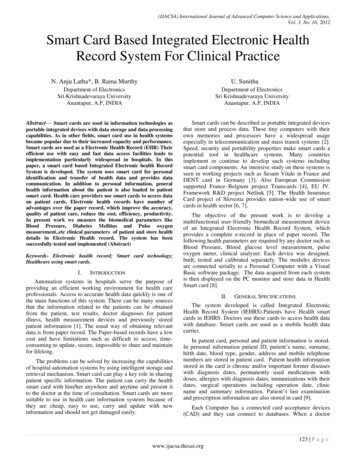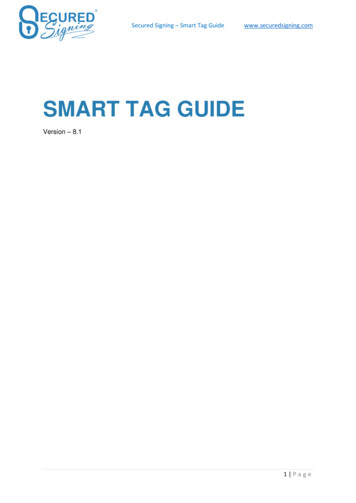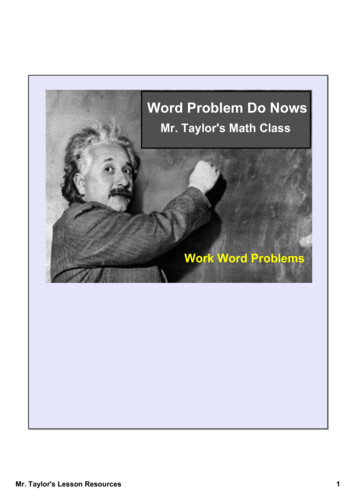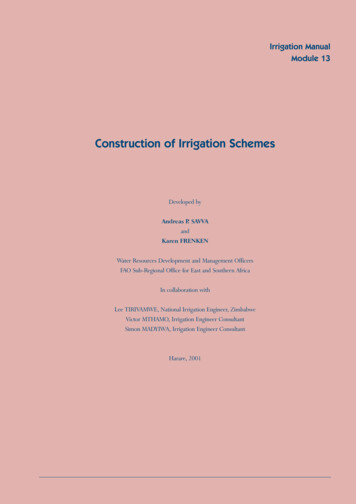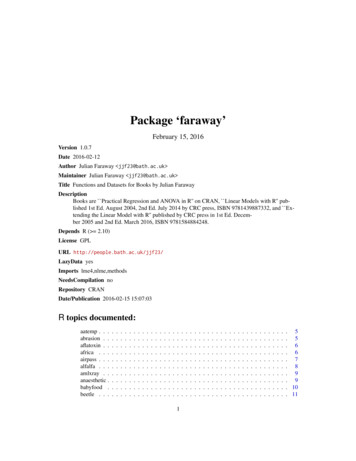
Transcription
International Journal of Pure and Applied MathematicsVolume 119 No. 15 2018, 1155-1168ISSN: 1314-3395 (on-line version)url: http://www.acadpubl.eu/hub/Special Issuehttp://www.acadpubl.eu/hub/SMART IRRIGATION SYSTEM1G.Ravi kumar, 2T.Venu Gopal, 3V.Sridhar, 4G.Nagendra1,3Assistant professor, 2,4Associate professor1,2,3,4Department of Electronics and communication Engineering1,2,3,4Vidya Jyothi Institute of Technology,Aziz Nagar,Hyderabad,Telangana,IndiaABSTRACT:The key objective of the paper is to monitor the soil’s moisture content during its dry and wetconditions with the aid of a moisture sensor circuit, calculate the corresponding relative humidityand irrigate it based on its nature using a PC based LabVIEW system, NI myRIO, IOT, GSM andan automatic water inlet setup which can also monitor and record temperature, humidity andsunlight, which is constantly modified and can be controlled in future to optimize these resourcesso that the plant growth and yield is maximized.A record of soil moisture, temperature, rainfall is maintained in a database for backup. Thisbackup is used for weather forecasting and directs the farmers regarding the type of crop to becultivated in future. IOT gives the whole information to the operator about the irrigation. In thispaper, we experiment for different soils suitable for different crops in various climatic parametersthat govern plant growth and allow information to be collected at high frequency and with lesslabor requirements.Keywords: soil moisture, irrigation, LabVIEW system, NI myRIO, IOT, GSM1. Introduction:Aim is to develop a wireless three level controlled smart irrigation system to provideirrigation system which is automatic for the plants which help in saving water and money. Themain objective is to apply the system for improvement of health of the soil and hence the plant viamultiple sensors. Appropriate soil water level is a necessary pre-requisite for optimum plantgrowth. Also, water being an essential element for life sustenance, there is the necessity to avoidits undue usage. Irrigation is a dominant consumer of water. This calls for the need to regulatewater supply for irrigation purposes. Fields should neither be over-irrigated nor under-irrigated.The objective of this thesis is to design a simple, easy to install methodology to monitor andindicate the level of soil moisture that is continuously controlled in order to achieve maximumplant growth and simultaneously optimize the available irrigation resources on monitoringsoftware LabVIEW and the sensor data can be seen on Internet. In order to replace expensivecontrollers in current available systems, the Arduino Uno will be used in this project as it is anaffordable microcontroller. The Arduino Uno can be programmed to analyze some signals fromsensors such as moisture, temperature, and rain. A pump is used to pump the fertilizer and waterinto the irrigation system. The use of easily available components reduces the manufacturing andmaintenance costs. This makes the proposed system to be an economical, appropriate and a lowmaintenance solution for applications, especially in rural areas and for small scale agriculturists.This research work enhanced to help the small-scale cultivators and will be increase the yield ofthe crops then will increase government economy.1155
International Journal of Pure and Applied MathematicsSpecial IssueOver time, systems have been implemented towards realizing this objective of whichautomated processes are the most popular as they allow information to be collected at highfrequency with less labor requirements. Bulk of the existing systems employ micro-processorbased systems. These systems offer several technological advantages but are unaffordable, bulky,difficult to maintain and less accepted by the technologically unskilled workers in the ruralscenario. The Internet of Things (IoT) is transforming the agriculture industry and enablingfarmers to contend with the enormous challenges they face. The industry must overcomeincreasing water shortages, limited availability of lands, difficult to manage costs, while meetingthe increasing consumption needs of a global population that is expected to grow up to 70% by2050. India’s major supply of financial gain is from agriculture sector and seventieth of farmersand general folks rely upon the agriculture. In Republic of India most of the irrigation systemssquare measure are operated manually. These antique techniques square measure replaced withsemi-automated and automatic techniques. The on the market ancient techniques square measurelike ditch irrigation, terraced irrigation, drip irrigation, system. The global irrigation situation isclassified by redoubled demand for higher agricultural productivity, poor performance anddecreased accessibility of water for agriculture. These issues are befittingly corrected if we have atendency to use machine-controlled system for irrigation.Automating farm or nursery irrigation permits farmers to use the correct quantity of waterat the correct time, regardless of the provision of labor to show valves on and off. Additionally,farmer’s mistreatment automation instrumentation is able to scale back runoff from over wateringsaturated soils, avoid irrigating at the incorrect time of day, which will improve crop performanceby making certain adequate water and nutrients once required. Those valves are also simplyautomated by mistreatment controllers. Automating farm or nursery irrigation permits farmers touse the correct quantity of water at the correct time, no matter the provision of labor to showvalves on and off. They lack in an exceedingly featured mobile application developed for userswith acceptable user interface. It solely permits the user to observe and maintain the wetness levelremotely in no matter of time. From the purpose of reading and performing at remote places thedeveloped microcontroller primarily based irrigation system will work perpetually for indefinitefundamental measure, even in sure abnormal circumstances.1.1 Objectives: To improve and stabilize the crop yields of smallholder olive farmers through theimplementation of sustainable irrigation systems.To promote water management practices thatoptimizes the volume and timing of water distribution. To generate positive economicconsequences for farmers and their families. Minimize year to year yield fluctuations, leading tohigher and more stable farm income.2. Proposed Method:2.1 Solar Power Based Smart Irrigation System:EXPERIMENTED BY- Department of Electrical and Electronics Engineering, AmritaUniversity Ettimadai, Coimbatore, India.AIM-Cost effective solar power can be the answer for all our energy needs. Solar powered smartirrigation systems are the answer to the Indian farmer. This system consists of solar poweredwater pump along with an automatic water flow control using a moisture sensor. It is the proposedsolution for the present energy crisis for the Indian farmers. This system conserves electricity byreducing the usage of grid power and conserves water by reducing water losses.1156
International Journal of Pure and Applied MathematicsSpecial IssueThey proposed to utilize the solar energy from solar panels to automatically pump waterfrom bore well directly into a ground level storage tank depending on the intensity of sunlight.While conventional methods include pumping of water from bore well into a well and from thiswell onto field using another pump, our system uses only a single stage energy consumptionwherein the water is pumped into a ground level tank from which a simple valve mechanismcontrols the flow of water into the field. This saves substantial amount of energy and efficient useof renewable energy. A valve is controlled using intelligent algorithm in which it regulates theflow of water into the field depending upon the moisture requirement of the land. In this systemwe use a soil moisture sensor that detects the amount of moisture present in the soil and dependingupon the requirement of level of moisture content required for the crop the water flow is regulatedthus, conserving the water by avoiding over flooding of crops.Proposed irrigation system mainly consists of two modules- Solar pumping module andautomatic irrigation module. In solar pumping module a solar panel of required specification ismounted near the pump set. Then using a control circuit it is used to charge a battery. From thebattery using a converter circuit it gives power to the water pump which is submerged inside thewell. Then the water is pumped into an overhead tank for storing water temporarily beforereleasing the water into the field. In automatic irrigation module the water outlet valve of the tankis electronically controlled by a soil moisture sensing circuit. The sensor is placed in the fieldwhere the crop is being cultivated. The sensor converts the moisture content in the soil intoequivalent voltage. This is given to a sensing circuit which has a reference voltage that can beadjusted by the farmer for setting different moisture levels for different crops. The amount ofwater needed for soil is proportional to the difference of these two voltages. A control signal wasgiven to a stepper motor whose rotational angle is proportional to the difference in voltage. Thestepper motor in turns controls the cross sectional area of the valve to be opened controlling flowof water. Therefore the amount of water flowing is proportional to the moisture difference.2.2 Smart Irrigation System Using Arduino:JOURNAL-SSRG International Journal of Electronics and Communication Engineering (ICRTECITA-2017) - Special Issue - March 201AIM-This paper design a model of automatic irrigation system which is based onmicrocontroller and solar power was used only for source of power supply. Various sensors areplaced in paddy field. Sensors sense water level continuously and give the information to farmerthrough cellular phone. Farmer controls the motor using cellular phone without going in paddyfield. If the water level reaches at danger level, automatically motor will be off withoutconformation of farmerThe aim of this paper is to modernize agriculture technology by programming componentsand built the necessary component for the system. The system is real time based and extracts theexact condition of paddy field. There is one central node used which to control other node. Themain function of RF module is to pass the message to the node and operate the system1157
International Journal of Pure and Applied MathematicsSpecial Issue3. Hardware Description:3.1 Ni My Rio (Reconfigurable Input Output):The National Instruments myRIO-1900 is aportable reconfigurable I/O (RIO) device that students can use to design control, robotics, andmechatronics systems. This document contains pinouts, connectivity information, dimensions,mounting instructions, and specifications for the NI myRIO-1900.Figure 3.1: NI MyRIO-19001. NI MyRIO-19002. MyRIO Expansion Port (MXP) Breakouts (one included in kit)3. Power Input Cable4. USB Device Cable5. USB Host Cable (not included in kit)6. LEDs7. Mini System Port (MSP) Screw-Terminal Connector8. Audio In/Out Cables (one included in kit)9. Button 04.Pin Connections Of Internal Project Modules:4.1 Hardware Connections:1. Connect myRIO to PC using USB cable RS232. 2. Soil moisture sensor, temperature sensor, light sensor are the analog sensors and thus connectedto analog input-output port of myRIO (port A, B or C). Rain sensor here is the only digital sensorused and thus connected to digital input-output port of myRIO 4.2 Soil moisture sensor:1. Soil moisture sensor’s Analog pin is given to port A- pin 3 of the RIO. 2.Its Vcc pin is given to the common terminal on the bread board which is given to port A- pin1( 5V) of the RIO and its GND terminal is given to port A- pin 11/pin 12. 4.3 Temperature sensor:1.Temperature sensor’s Vcc pin is given to the 5V pin (in Port C) of the RIO and its GND terminalis given to the common ground on the bread board which is connected to the AGND (Analogground) pin of the RIO. 2.An analog input is fed to AI0 (0 ) pin and AI0 (0- ) is given to AGND probably through acommon ground on the bread board. 4.4 Rain Sensor:1.Rain sensor’s Vccpin is given to the 5V pin (in Port C) of the RIO and its GND terminal is givento the DGND (Digital ground) terminal of the RIO. 2.Digital output (DO) pin of the sensor is given to DIO0 pin of the RIO. 1158
International Journal of Pure and Applied MathematicsSpecial Issue4.5 Light sensor:1. Connect a 100Ω resistor in series with light sensor.2. Connect sensor’s one end to AIO (1 )-port C and AIO (1-) to AGND. 3. Give sensor’s another end to 5V of RIO. 4.6 Motor Driver:Input Voltage section1. Positive pin is connected to 5V of the RIO 2. Negative pin is given to digital ground (DGND). Motorsection- (Motor output) Positive pin is connected to positive terminal of the water pump used. Negative terminal of the water pump is given to negative pin of the motor output. In addition to these, we also make use of two control pins for controlling themotor.Port C- DIO3 Port C- DGNDFigure 4.1: Hardware connections testing in different soils1159
International Journal of Pure and Applied MathematicsSpecial Issue5 .Proposed methodology:This paper emphasizes on the fact that the technique which is incorporated here to monitorthe soil’s moisture content, enables agriculturalists feasibility of humidity measurement and aconventional automatic irrigation with the potential for eliminating excessive irrigation cyclesthereby saving water to a significant extent. Besides the normal modes of measurement andanalysis, Lab VIEW stands unique as grooming software in the field of Instrumentation andcontrol engineering, which facilitates engineers to work in one platform with infinite possibilitiesalong with a sophisticated control system. Effective crop treatment and water management is themajor requisite in most of the cultivating estates in semi-arid regions. Monitoring the soil’s nature,estimating it’s moisture content and controlling it concurring to the necessity, proposes a potentialsolution to endorse landsite irrigation management and thus, to treat desiccated fields and provideprominent yield to producers.In the field of agriculture the most important part is, to get theinformation about the moisture content of soil.The paper is designed to develop an automatic irrigation system which switches the pumpmotor ON/OFF on sensing the moisture content of the soil. In the field of agriculture, use ofproper method of irrigation is important .This project is implemented in the Lab VIEWenvironment by interfacing MyRio. Corresponding to the surface’s atmospheric conditions,transmission of the sensed voltage signal from the hardware circuitry on the Rio interfaced to a PCwith Lab VIEW , which uses a development environment that is powerful and intuitive whichcould rapidly develop a user interface for data visualization and automatic irrigation of the soil.The advantage of using this method is to reduce human intervention and still ensure properirrigation.5.1 Block Diagram:This section elaborates the assessing and controlling of the moisture content in the soilusing Lab VIEW. The hardware and software implementation are discussed here below. Theblock diagram shows the flow of how the complete process is carried outFigure 5.1: Basic block diagram of monitoring and controlling moisture content in the soil1160
International Journal of Pure and Applied Mathematics6. FLOW CHART:Figure 6.Flowchart for motor controlFigure 6.1: Software code which obeys the flowchart1161Special Issue
International Journal of Pure and Applied MathematicsSpecial Issue6.1.1 DRY CONDITION (WITHOUT RAIN):5. If the sensed signal is greater than the threshold voltage for every particular soil, it means itexecutes the true condition and thus the soil is dry. 6. The above statement is based on the property of the moisture sensor, i.e., if the sensed value isgreater than or equal to the threshold voltage, then the soil is dry and also if there is no rain. 7. Because the condition is true, the Boolean LED will glow ON and the water pump should turnON in order to irrigate the plant. Figure 6.2: Front panel output in dry condition (without rain)6.1.2 DRY CONDITION (WITH RAIN):6. If the sensed signal is greater than the threshold voltage for every particular soil, it means itexecutes the true condition and thus the soil is dry. 7. The above statement is based on the property of the moisture sensor, i.e., if the sensed value isgreater than or equal to the threshold voltage, then the soil is dry. 8. Because the condition is true, the Boolean LED will glow ON and the water pump should turnON in order to irrigate the plant. 9. When it’s raining, even though the soil is dry, automatically motor gets turned OFF. After the rain stops, it again checks the condition of soil moisture and work accordingly.1162
International Journal of Pure and Applied MathematicsSpecial IssueFigure 6.3: Front panel output in dry condition (with rain)6.1.3 Wet Condition:8.If the sensed signal is less than the threshold voltage for every particular soil, it meansit executes the false condition and thus the soil is wet. 9.above statement is based on the property of the moisture sensor, i.e., if the sensed valueis less than the threshold voltage, then the soil is wet. 10.Because the condition is false, the Boolean LED will glow OFF and the water pumpshould turn OFF because the plant has excess of water content in the soil, irrespective ofrain Figure 6.4: Front panel output in wet condition1163
International Journal of Pure and Applied MathematicsSpecial Issue6.2 Execution Process:After giving the hardware and software connections as mentioned above, the process ofimplementation is this paper is discussed below:9. After constructing the block diagram in the software (Lab VIEW) and giving the hardwareconnections, click run simulation. 10. The functional process of this project has 4 main conditions. They are dry condition and wetconditions with and without rain. 11. These conditions are verified by keeping the soil sensor in the soil. 12. When the sensor is kept in soil, the sensor senses analog voltage value and is given to portA pin-3 of the RIO. 13. This analog voltage is then compared with the threshold voltage of different soils (Black,Red, Clay). 14. Then the result is given to the NOR gate which has 4 cases. RAINSOIL MOISTUREMOTOR CONDITIONLow(No Rain)Low (Dry)ONLow (No rain)High (Wet)OFFHighLow (Dry)OFFHighHigh (Wet)OFFTable 6.1: NOR gate condition1164
International Journal of Pure and Applied Mathematics7. Experimental Results:7.1 ResultsFigure7.1: output in dry condition (without rain)Figure7.2: Output in dry condition (with rain)Figure 7.3: Output in wet condition1165Special Issue
International Journal of Pure and Applied MathematicsSpecial IssueTable 7.1: Experimental output Red soil consists of less moisture content and hence it absorbs water quickly. Black soil keeps moisture for longer time, so it require less water and itsabsorption level are slower than red soil. Clay consists of more water. It requires less water and absorbs very slowlycompared to red and black soils 8. Conclusion:This paper involves establishing a contemporary design technique of monitoring andcontrolling the moisture level of soil using LabVIEW. Providing comprehensive tools that needto build any measurement or control application in dramatically less time. The project alsoincludes rain sensor, which is very important in the project to avoid unnecessary power wastage.No longer only are farmers able to generally use much less water to grow a crop, they're able toincrease growth yields and the satisfactory of the crop by using better management of soilmoisture at some point of vital plant growth degrees. Embedded system for computerizedirrigation of an agriculture subject gives an able solution to assist web page- precise irrigationcontrol that permits producers to maximize their productivity whilst saving the water.1166
International Journal of Pure and Applied MathematicsSpecial Issue9. Future Scope:We can interface LCD screen in order to display the current status of the soil moisturecontent levels, percentage of water utilized to water the plant, duration of time for which thewater pump is ON, etc. We can also show the graphical representation of the moisture contentlevels in the soil. To improve the efficiency and effectiveness of the system, the followingrecommendations can be put into consideration. Option of controlling the water pump can begiven to the farmer. The farmer may choose to stop the growth of crops or the crops may getdamaged due to adverse weather conditions. In such cases farmer may need to stop the systemremotely.The idea of using IOT for irrigation can be extended further to other activities infarming such as cattle management, fire detection and climate control. This would minimizehuman intervention in farming activities.10. References:[1] “Monitoring and Control of Relative Humidity in Soil using LabVIEW” , InternationalJournal of Engineering Trends and Technology (IJETT) – Volume 9 Number 10 - Mar 2014[2] http://ethesis.nitrkl.ac.in/3342/1/Hardware Implementation of Soil Moisture Monitoring System.pdf[3] http://www.ni.com/white-paper/7588/en/[4] https://en.wikipedia.org/wiki/LabVIEW#Interfacing to devices1167
1168
controllers in current available systems, the Arduino Uno will be used in this project as it is an affordable microcontroller. The Arduino Uno can be programmed to analyze some signals from sensors such as moisture, temperature, and rain. A pump is used to p
